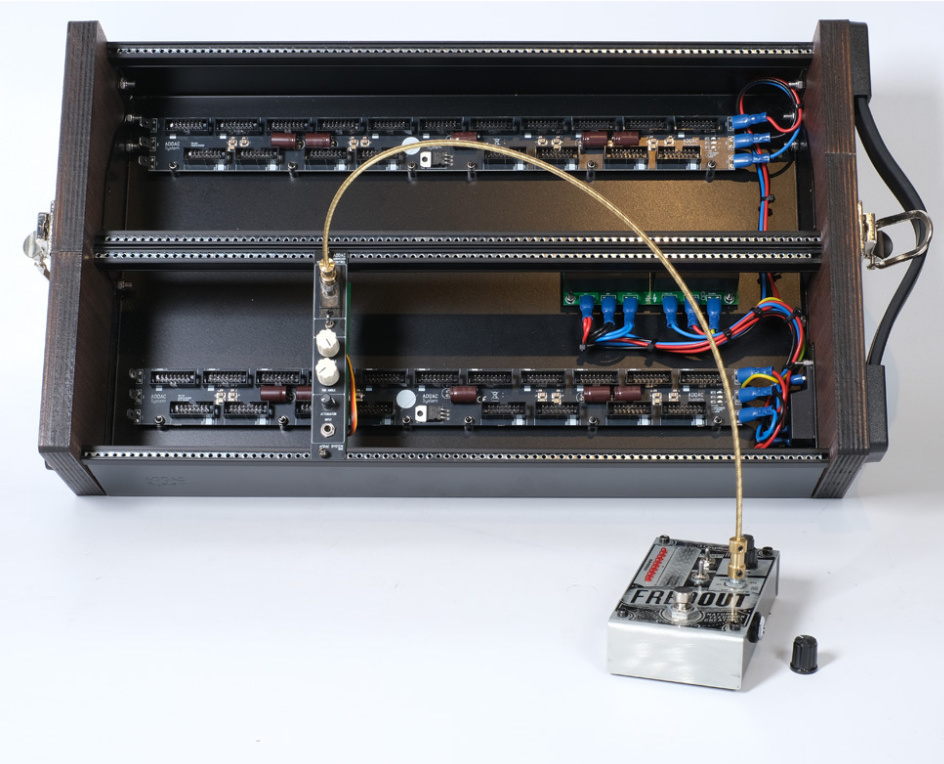SUPERBOOTH25: ADDAC System Launches Trio of Modules, Including Servo Control, Dual Envelope Follower+ and Crossover
ADDAC320 Servo Control uses motor to control parameters on modules with no CV input, or external gear like guitar pedals
Lisbon, Portugal, May 5, 2025 — ADDAC System announces a trio of new modules for Superbooth25: ADDAC320 Servo Control, ADDAC220 Dual Envelope Follower+, and ADDAC607 Crossover. All three modules are available now from ADDAC System and through its network of distributors around the world.
Combining ingenuity and engineering for enhanced control
The new ADDAC320 Servo Control is a Eurorack-styled nod to Neil Young’s Whizzer, a device that was ahead of its time. This tool enabled control over amplifier pots through the use of pedals, resulting in far-reaching tonal variation. Inspired by this methodology, ADDAC's Servo Control incorporates a Servo motor into a 4 HP Eurorack module, enabling it to control any knob that doesn't have a CV input, or other gear such as guitar pedals - within certain distance constraints.
A servo is a specific type of motor that can be digitally controlled to work at precise angles. On the ADDAC320, it is controlled by a microcontroller which is able to receive an incoming CV voltage from 0 to +5v and linearly converts this voltage range to the 270 degree Servo motor range. Using a spring wire and metal couplers, the motor shaft is then attached to the target knob to be controlled, which will turn as the Servo turns. Two other knobs, Maximum Angle and Minimum Angle, allow further control of the “sweet spot” of the target knob, establishing a smaller Servo range.
.jpg)
Dual Envelope Follower+: an analog/digital hybrid for better dynamic range analysis
The new ADDAC220 Dual Envelope Follower + is the company's latest stereo envelope follower, which can generate CV from two simultaneous envelopes, enabling the user to control any range of other instrument / module parameters. The module is an analog/digital hybrid, allowing greater precision and analysis of an incoming signal.
The level of an incoming audio signal gain can be set by using the Gain control. Then, the signal is then fully rectified and passed through an analog envelope follower with a fixed short attack and decay. The analog signal is then sent into a 12bit ADC (analog to digital converter) of an MCU (microcontroller unit), and hereafter the signal is processed digitally. Whenever the ADC detects audio clipping the Clip led will light up.

Then, the digitized signal is then passed through a Savitsky-Golay filter for noise reduction smoothing of the incoming signal, before it is slewed using the Attack and Decay controls. The MCU keeps a history of the last sampling points and detects the minimum and maximum values, which reflect the current dynamic range and maps the signal minimum and maximum amplitude to 0V and the maximum voltage detected.
This new mapped signal is then processed via the Response Curve control balacing the response like one would with a standard AD envelope with LOG/EXP control. The Envelope Gain attenuverter control goes up to x2 amplification and sets the attenuation / amplification factor of the output range, while the red LED monitors this level with precise visualization across the full output range.

Crossover: enabling new processing possibilities
Commonly, audio crossovers are designed to split an audio signal into several frequency ranges so that each resulting signal is adequate for the speaker drivers they are connected to. Typically, low range is sent to the big woofers, mid range to smaller woofers and high range to the tweeters.
Introducing the ADDAC607, which enables users to split the signal into different bands. This creates many interesting processing possibilities. For example, by independently processing specific frequency ranges, one can add delay on only the high frequency range. Or, users split a signal to feed three different compressors for multi-band compression. Finally, DJs can use the Gain knob as a 'kill switch' to remove an entire frequency band, if desired.
Although ADDAC607 operates in Mono (for Stereo signals two modules can be used) there are two audio inputs, making it easy to achieve stereo to mono summing. The Mono Sum Out carries this summed signal. This is pre-gain and can also be used as a buffered Thru output.
The ADDAC607 is a great companion to the ADDAC220 Dual Envelope Follower+, since it allows extraction of dynamics from any signal in a focused frequency range. This allows it to separate the frequencies of a kick drum and a snare, for instance.
For information on any of the new ADDAC320 Servo Control, the ADDAC220 Dual Envelope Follower+ or the ADDAC607 Crossover, please visit the ADDAC System website.
About ADDAC System
ADDAC develops advanced instruments for sonic expression. The company started back in 2009 with an ambition to explore the potential crossover between analog synthesizers and computers. Because its first creations sparked a lot of attention, ADDAC decided to work hard and put them in customers' hands. Today our product line is focused on a new breed of hybrid synths, that make use of the best of both the digital and analog worlds. We've grown to be able to reach thousands of enthusiastic clients, friends and collaborators. Always looking into conceptualizing and developing the most exquisite instruments, we hope you're able to join and share this passion with us.
Our solutions can be found in many personal studio throughout the world, owned by musicians in several planes of stardom. We especially appreciate seeing them being used in a very wide range of musical genres.
Jeff Touzeau












